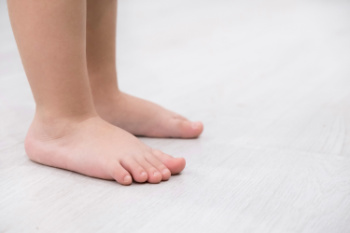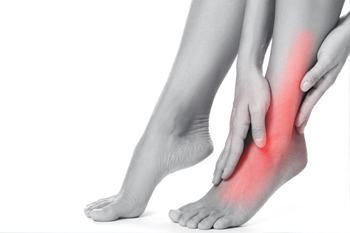
Flat feet, also known as fallen arches, are a common condition where the arches of the feet touch the ground when standing. While it is normal for babies and toddlers to have flat feet due to underdeveloped arches, most children develop arches by the age of six. However, some children continue to have flat feet into adolescence and adulthood. In many cases, flat feet do not cause any problems or require treatment, although some children may experience foot pain, stiffness, or difficulty with activities like running or sports. It is important for parents to monitor their child's foot development and seek medical attention if they have concerns about flat feet. A podiatrist can assess the child's feet and recommend appropriate interventions, such as wearing supportive footwear or custom orthotic inserts. By understanding flat feet and seeking timely intervention when needed, parents can help ensure their child's foot health and overall well-being. If your child has maintained flat feet beyond the age of six, it is strongly suggested that you confer with a podiatrist who can monitor your child’s condition.
Flatfoot is a condition many people suffer from. If you have flat feet, contact Dr. Richard T. Bauer from Summit Foot & Ankle. Our doctor will treat your foot and ankle needs.
What Are Flat Feet?
Flatfoot is a condition in which the arch of the foot is depressed and the sole of the foot is almost completely in contact with the ground. About 20-30% of the population generally has flat feet because their arches never formed during growth.
Conditions & Problems:
Having flat feet makes it difficult to run or walk because of the stress placed on the ankles.
Alignment – The general alignment of your legs can be disrupted, because the ankles move inward which can cause major discomfort.
Knees – If you have complications with your knees, flat feet can be a contributor to arthritis in that area.
Symptoms
- Pain around the heel or arch area
- Trouble standing on the tip toe
- Swelling around the inside of the ankle
- Flat look to one or both feet
- Having your shoes feel uneven when worn
Treatment
If you are experiencing pain and stress on the foot you may weaken the posterior tibial tendon, which runs around the inside of the ankle.
If you have any questions please feel free to contact our office located in Latham, NY . We offer the newest diagnostic and treatment technologies for all your foot and ankle needs.

Foot pain, a pervasive issue affecting individuals of all ages, warrants a comprehensive understanding to address its diverse origins and alleviate discomfort. Defined as discomfort or soreness experienced anywhere in the foot, foot pain can stem from a multitude of factors. Common causes include biomechanical issues such as flat feet, high arches, or abnormal gait patterns, which place undue stress on the feet. Additionally, injuries like sprains, strains, or fractures, whether from sports activities or accidents, contribute to foot pain. Footwear choices play a significant role, with ill-fitting shoes, high heels, or worn-out footwear exacerbating discomfort. Furthermore, medical conditions such as arthritis, plantar fasciitis, neuropathy, and tendonitis can manifest as persistent foot pain. Lifestyle factors like obesity, poor posture, and occupational demands also impact foot health. If you are experiencing any type of foot pain, it is strongly suggested that you seek the guidance of a podiatrist who can accurately diagnose and offer a treatment plan that is right for you.
Foot Pain
Foot pain can be extremely painful and debilitating. If you have a foot pain, consult with Dr. Richard T. Bauer from Summit Foot & Ankle. Our doctor will assess your condition and provide you with quality foot and ankle treatment.
Causes
Foot pain is a very broad condition that could be caused by one or more ailments. The most common include:
- Bunions
- Hammertoes
- Plantar Fasciitis
- Bone Spurs
- Corns
- Tarsal Tunnel Syndrome
- Ingrown Toenails
- Arthritis (such as Gout, Rheumatoid, and Osteoarthritis)
- Flat Feet
- Injury (from stress fractures, broken toe, foot, ankle, Achilles tendon ruptures, and sprains)
- And more
Diagnosis
To figure out the cause of foot pain, podiatrists utilize several different methods. This can range from simple visual inspections and sensation tests to X-rays and MRI scans. Prior medical history, family medical history, and any recent physical traumatic events will all be taken into consideration for a proper diagnosis.
Treatment
Treatment depends upon the cause of the foot pain. Whether it is resting, staying off the foot, or having surgery; podiatrists have a number of treatment options available for foot pain.
If you have any questions, please feel free to contact our office located in Latham, NY . We offer the newest diagnostic and treatment technologies for all your foot care needs.

Morton's neuroma, a painful condition characterized by thickening of the tissue around a nerve leading to the toes, can significantly impact mobility and quality of life. When conservative treatments fail to provide adequate relief, surgical intervention becomes a viable option. The surgical approach aims to decompress the affected nerve and remove the enlarged tissue causing compression and discomfort. Typically performed under local anesthesia, surgical techniques vary depending on the severity of the neuroma and individual patient factors. Common procedures include neurectomy, wherein the affected nerve segment is excised, or decompression, which involves releasing pressure on the nerve through various means. Minimally invasive techniques, such as endoscopic decompression, offer reduced recovery times and fewer complications compared to traditional open surgery. While surgery for Morton's neuroma carries risks like any other procedure, it can offer significant relief from persistent pain and allow individuals to regain mobility and resume daily activities with greater comfort and ease. If you have Morton’s neuroma and are considering surgery for relief, it is suggested that you consult a podiatrist who can determine if this is the right choice for you.
Foot surgery is sometimes necessary to treat a foot ailment. To learn more, contact Dr. Richard T. Bauer of Summit Foot & Ankle. Our doctor will assist you with all of your foot and ankle needs.
When Is Surgery Necessary?
Foot and ankle surgery is generally reserved for cases in which less invasive, conservative procedures have failed to alleviate the problem. Some of the cases in which surgery may be necessary include:
- Removing foot deformities like bunions and bone spurs
- Severe arthritis that has caused bone issues
- Cosmetic reconstruction
What Types of Surgery Are There?
The type of surgery you receive will depend on the nature of the problem you have. Some of the possible surgeries include:
- Bunionectomy for painful bunions
- Surgical fusion for realignment of bones
- Neuropathy decompression surgery to treat nerve damage
Benefits of Surgery
Although surgery is usually a last resort, it can provide more complete pain relief compared to non-surgical methods and may allow you to finally resume full activity.
Surgical techniques have also become increasingly sophisticated. Techniques like endoscopic surgery allow for smaller incisions and faster recovery times.
If you have any questions please feel free to contact our office located in Latham, NY . We offer the newest diagnostic and treatment technologies for all your foot and ankle needs.

